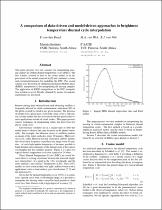 ResearchSpace
ResearchSpace
Comparison of data-driven and model-driven approaches to brightness temperature diurnal cycle interpolation
JavaScript is disabled for your browser. Some features of this site may not work without it.
- ResearchSpace
- →
- Research Publications/Outputs
- →
- Conference Publications
- →
- View Item
| dc.contributor.author |
Van den Bergh, F

|
|
| dc.contributor.author |
Van Wyk, MA

|
|
| dc.contributor.author |
Van Wyk, BJ

|
|
| dc.date.accessioned | 2007-07-05T10:37:21Z | |
| dc.date.available | 2007-07-05T10:37:21Z | |
| dc.date.issued | 2006 | |
| dc.identifier.citation | Van den Bergh, F, Van Wyk, MA and Van Wyk, BJ. 2006. Comparison of data-driven and model-driven approaches to brightness temperature diurnal cycle interpolation. 17th Annual Symposium of the Pattern Recognition Association of South Africa, Parys, South Africa, 29 Nov - 1 Dec 2006 | en |
| dc.identifier.uri | http://hdl.handle.net/10204/991 | |
| dc.description.abstract | This paper presents two new schemes for interpolating missing samples in satellite diurnal temperature cycles (DTCs). The first scheme, referred to here as the cosine model, is an improvement of the model proposed in [2] and combines a cosine and exponential function for modelling the DTC. The second scheme uses the notion of a Reproducing Kernel Hilbert Space (RKHS) interpolator [1] for interpolating the missing samples. The application of RKHS interpolators to the DTC interpolation problem is novel. Results obtained by means of computer experiments are presented. | en |
| dc.language.iso | en | en |
| dc.subject | Diurnal temperature cycles | en |
| dc.subject | DTC | en |
| dc.subject | Land surface temperature | en |
| dc.subject | LST | en |
| dc.subject | Meteosat second generation | en |
| dc.subject | MSG | en |
| dc.subject | Reproducing kernel hilbert space | en |
| dc.title | Comparison of data-driven and model-driven approaches to brightness temperature diurnal cycle interpolation | en |
| dc.type | Conference Presentation | en |
| dc.identifier.apacitation | Van den Bergh, F., Van Wyk, M., & Van Wyk, B. (2006). Comparison of data-driven and model-driven approaches to brightness temperature diurnal cycle interpolation. http://hdl.handle.net/10204/991 | en_ZA |
| dc.identifier.chicagocitation | Van den Bergh, F, MA Van Wyk, and BJ Van Wyk. "Comparison of data-driven and model-driven approaches to brightness temperature diurnal cycle interpolation." (2006): http://hdl.handle.net/10204/991 | en_ZA |
| dc.identifier.vancouvercitation | Van den Bergh F, Van Wyk M, Van Wyk B, Comparison of data-driven and model-driven approaches to brightness temperature diurnal cycle interpolation; 2006. http://hdl.handle.net/10204/991 . | en_ZA |
| dc.identifier.ris | TY - Conference Presentation AU - Van den Bergh, F AU - Van Wyk, MA AU - Van Wyk, BJ AB - This paper presents two new schemes for interpolating missing samples in satellite diurnal temperature cycles (DTCs). The first scheme, referred to here as the cosine model, is an improvement of the model proposed in [2] and combines a cosine and exponential function for modelling the DTC. The second scheme uses the notion of a Reproducing Kernel Hilbert Space (RKHS) interpolator [1] for interpolating the missing samples. The application of RKHS interpolators to the DTC interpolation problem is novel. Results obtained by means of computer experiments are presented. DA - 2006 DB - ResearchSpace DP - CSIR KW - Diurnal temperature cycles KW - DTC KW - Land surface temperature KW - LST KW - Meteosat second generation KW - MSG KW - Reproducing kernel hilbert space LK - https://researchspace.csir.co.za PY - 2006 T1 - Comparison of data-driven and model-driven approaches to brightness temperature diurnal cycle interpolation TI - Comparison of data-driven and model-driven approaches to brightness temperature diurnal cycle interpolation UR - http://hdl.handle.net/10204/991 ER - | en_ZA |





